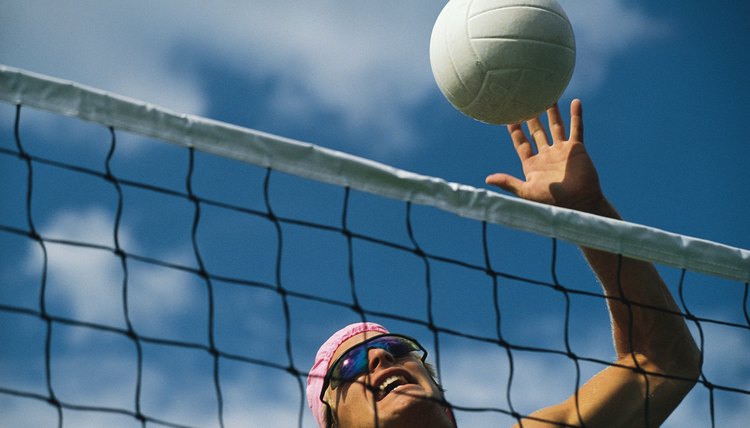How To Make a Volleyball Court

Volleyball originated in the United States in the late 1800s, and it's now played by more than 800 million people worldwide on a regular basis. If you're one of them, you may eventually have the desire to build your own court, either in your backyard or on the beach. While the basic setup is fairly simple, making your own volleyball court does take some time to prepare the ground and ensure that the various components of the court are installed safely.
Sand Court Prep
Select a location that is flat and has good drainage. Excavate the playing area -- which will be 60 feet long and 30 feet wide -- by removing the surface material to a depth of 1 to 3 feet. If the area is more prone to standing water, dig closer to the 3-foot level, and install a perforated drainage pipe leading away from the lowest portion of the court and well away from the court area. If you're not sure of the grade of the land you want to use, you may need to hire a surveyor to help you determine the lowest point in the area.
Cover the area with a layer of pea gravel, if you plan to install sand. If the drainage is good, this layer can be just 1 or 2 inches; for areas that tend to hold more water, place as much as 1 foot of pea gravel over the area. Rake the area to make it flat.
Cover the pea gravel layer with a layer of landscape fabric to keep the gravel and sand from mixing.
Dump a 1- to 2-foot layer of sand on the court, and then rake it to make it flat. Be sure to get volleyball sand instead of golf course or masonry sand, as those other types can be grittier and have more dust.
Nets and Marking
Measure the court lengthwise to 59 feet. Measure the court's width to 29.6 feet.
Place 2-inch, brightly colored marking tape or rope on the inside of 59-foot and 29.6-foot lines to mark the outside of the playing court. The tape should be 2 inches wide and start on the inside edge of the markings.
Measure halfway between the 59-foot long border and place another piece of tape or rope across the width of the court to mark the center line.
Place a piece of marking tape or rope on either side of the center line to mark the attack lines. These lines are supposed to be 3 meters -- or about 9.84 feet -- from the center line, so measure and mark accordingly. If you are installing a sand court, you do not need to mark the attack lines, since having a piece of rope or tape in the middle of the court could be a trip hazard.
Dig holes on either side of the center line, about 2 feet from the outside of the court. The holes should be about 1 foot across and 3 feet down.
Place 10.5-foot or higher net poles into the holes, placing the poles at least 3 feet into the ground, and then fill with concrete. The poles can be made of any type of sturdy material, including 6 x 6 treated wood, steel or anodized aluminum. As the concrete sets, use a level to ensure that the poles stay straight.
Install your net according to the manufacturer's instructions and the desired height. Women's courts should have a net that is 7 feet, 4 inches high, while a men's court should be 8 feet high. Coed games are traditionally played at men's height. For sand volleyball, the height of the court should be based on the height of the sand, not the height of the sand when your foot is in it. For grass, use the height of the ground, not the grass.
Tips
As you select your location, be sure to place the court so that the ends of the court face north and south. This will prevent the sun from getting in the eyes of players during early morning and evening games.
Different groups have different guidelines for how much space to have on the outside of the court to avoid obstructions; generally, though, you should have at least 6 feet on all sides of the court for safety.
References
Writer Bio
Nicole Vulcan has been a journalist since 1997, covering parenting and fitness for The Oregonian, careers for CareerAddict, and travel, gardening and fitness for Black Hills Woman and other publications. Vulcan holds a Bachelor of Arts in English and journalism from the University of Minnesota. She's also a lifelong athlete and is pursuing certification as a personal trainer.
